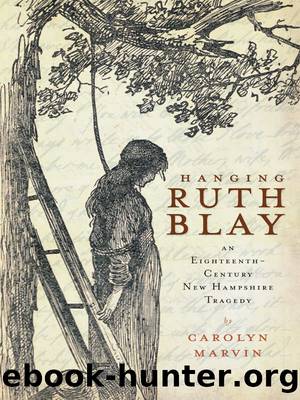Hanging Ruth Blay_An Eighteenth-Century New Hampshire Tragedy by Carolyn Marvin

Author:Carolyn Marvin [Marvin, Carolyn]
Language: eng
Format: epub
Publisher: Arcadia Publishing
Published: 2010-06-04T06:00:00+00:00
The law regarding concealment repeated in the preface to the Reverend Shurtleffâs execution sermon for Sarah Simpson. Courtesy of the New Hampshire Historical Society.
In the published laws of 1759 appears âAn Act to Prevent the Destroying and Murdering of Bastard Children.â The law itself is prefaced by the justification for it and reads as follows:
Whereas many lewd women that have been delivered of bastard children, to avoid their shame, and to escape punishment, do secretly bury or conceal the death of their children, and after, if the child be found dead, the said woman to allege that the said Child was born dead: Whereas it falleth out sometimes, (althoâ hardly it is to be proved) that the said child or children were murdered by the said women their lewd mothers, or by their assent or procurement:
Be it therefore Enacted by the Governor, Council, and Representatives, convened in General Assembly, and by the Authority of the same:
That if any woman be delivered of any issue of her body, male or female, which if it were born alive should by law be a bastard, and they endeavor privately, either by drowning, or secret burying thereof, that it may not come to light, whether it was born alive or not, but be concealed; in every such case the mother so offending shall suffer death, as in case of murder, except such mother can make proof, by one witness at the least, that the child whose death was by her so intended to be concealed, was born dead.86
Statistically, the indictment and conviction rate for this crime in both England and New England experienced rises and falls. It rose throughout the first half of the eighteenth century, and then began to wane again.87 Clearly, it represented a reflection of the perceived immorality of the time, and social or political unrest seems to have paralleled that perception. Notice that the very language in the preface assumes the impropriety of the woman; it is not modified at all by the circumstance of the pregnancy. She is presumed to be a âlewdâ woman.
The laws regarding fornication and bastardy mandated much less severe punishment. Fornication was punishable by whipping and fines to both parties; bastardy, if the father was named during the womanâs travail and this was witnessed by midwife or friend, was punishable by financial responsibility for the child and/or imprisonment until he could assure the town that he would be financially responsible for said child.88
In provincial New Hampshire, as in other colonies, these laws were tested. During the second half of the eighteenth century, societal order was indeed being challenged on all sides. It is obvious that whenever the established order is threatenedâbe it politically, legally, morally, spiritually or sociallyâthe application of the established controls is more stringent. Certainly this was true in 1739 for Sarah and Penelope with the throat distemper and the Great Awakening fresh in peopleâs minds, and it would be true again in the pre-revolutionary unrest of 1768.
Ruth was not the first to
Download
This site does not store any files on its server. We only index and link to content provided by other sites. Please contact the content providers to delete copyright contents if any and email us, we'll remove relevant links or contents immediately.
What's Done in Darkness by Kayla Perrin(25501)
Shot Through the Heart: DI Grace Fisher 2 by Isabelle Grey(18220)
Shot Through the Heart by Mercy Celeste(18160)
The Fifty Shades Trilogy & Grey by E L James(17777)
The 3rd Cycle of the Betrayed Series Collection: Extremely Controversial Historical Thrillers (Betrayed Series Boxed set) by McCray Carolyn(13190)
The Subtle Art of Not Giving a F*ck by Mark Manson(12915)
Scorched Earth by Nick Kyme(11833)
Stepbrother Stories 2 - 21 Taboo Story Collection (Brother Sister Stepbrother Stepsister Taboo Pseudo Incest Family Virgin Creampie Pregnant Forced Pregnancy Breeding) by Roxi Harding(11040)
Drei Generationen auf dem Jakobsweg by Stein Pia(10217)
Suna by Ziefle Pia(10186)
Scythe by Neal Shusterman(9264)
International Relations from the Global South; Worlds of Difference; First Edition by Arlene B. Tickner & Karen Smith(8613)
Successful Proposal Strategies for Small Businesses: Using Knowledge Management ot Win Govenment, Private Sector, and International Contracts 3rd Edition by Robert Frey(8419)
This is Going to Hurt by Adam Kay(7698)
Dirty Filthy Fix: A Fixed Trilogy Novella by Laurelin Paige(6454)
He Loves Me...KNOT by RC Boldt(5805)
How to Make Love to a Negro Without Getting Tired by Dany LaFerrière(5378)
Interdimensional Brothel by F4U(5305)
Thankful For Her by Alexa Riley(5164)
